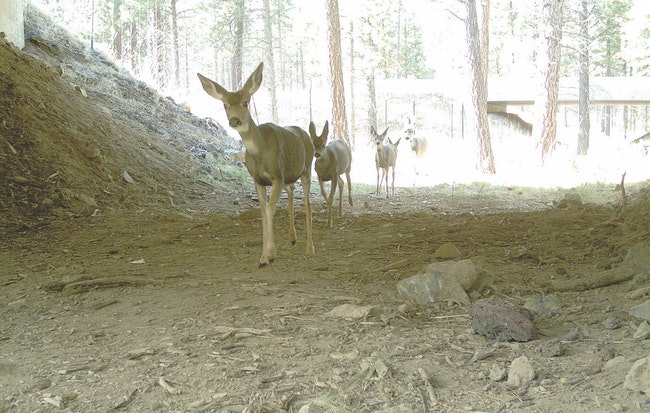
Mule deer cross the road using an underpass at Lava Butte. (Enterprise/FILE)
Every year, collisions between vehicles and deer on U.S. Highway 20 west of Vale cost more than $1 million.
State officials found that the highway between Harper and Juntura had among the highest rates of such collisions anywhere in Oregon.
A plan is unfolding to develop wildlife crossings along a roughly 30-mile stretch, using a share of $7 million set aside by the Oregon Legislature earlier this year.
Solutions range from modifying bridges, fencing and more elaborate structures.
A meeting has been scheduled for 5 p.m. Monday, June 13, at Juntura School in Juntura to consider the options. Representatives from the Oregon Department of Transportation, Oregon Department of Fish and Wildlife, and the Burns Paiute Tribe Natural Resources Department will review findings from a feasibility study and seek local opinions about solutions.
The Transportation Department described the scope of the problem in Oregon in a Feb. 2 report to the Legislature, noting that there are about 6,500 reported wildlife-vehicle collisions a year in Oregon. The true number is likely double that, the report said, “due to the high number of unreported collisions.”
Such collisions “result in costly vehicle damage and human injuries or death,” the report said.
A feasibility study identified the Highway 20 corridor as a place with a heavy concentration of mule deer, with herds spending winter months in the area.
“These deer cross and recross the highway numerous times,” the study found. Collars on deer provided data revealing deer crossing as many as 370 times during fall and winter months, the study said.
The study suggested retrofits along Highway 20 “including creation of unobstructed pathways under the existing bridges, removal of derelict fencing and debris, conduct surface grading to increase height, improve openness and increase line of sight.”
The report estimated a “simple” retrofit to five bridges would cost $1.215 million. More sophisticated changes could cost $2.29 million and wildlife overpasses could cost $3.9 million to $7.1 million.
The Oregon Hunters Association was one group that lobbied for state funding for the wildlife crossings.
“Our state is far behind other western states in this critical effort to improve wildlife passage,” the association said in a statement in December. “We have a long way to go.”
Oregon has five wildlife crossings compared to 69 in Colorado and 50 in both Utah and California.
According to an insurer’s report, Oregon has the highest likelihood of wildlife collisions among West Coast states.
The Oregon Wildlife Foundation also supported more state funding for crossing projects.
“The economic, ecological and personal damage is profound,” the foundation said in written testimony earlier this year to legislators. “On the ecological front, all wildlife must move to find food, mates and safety. Some of that movement is migration that put wildlife and Oregon drivers in harm’s way.”
The state’s first wildlife crossing project was installed in 2012 on U.S. Highway 97 at Lava Butte, south of Bend. The number of wildlife collisions in that area dropped 85% and 30 species used the underpass, according to the Transportation Department.
EXCELLENCE IN JOURNALISM – Available for $5 a month. Subscribe to the digital service of the Enterprise and get the very best in local journalism. We report with care, attention to accuracy, and an unwavering devotion to fairness. Get the kind of news you’ve been looking for – day in and day out from the Enterprise.




